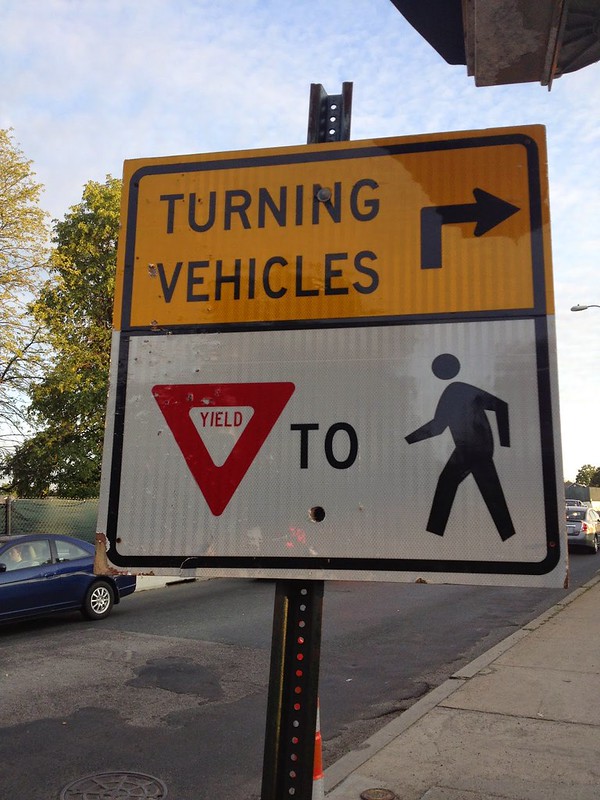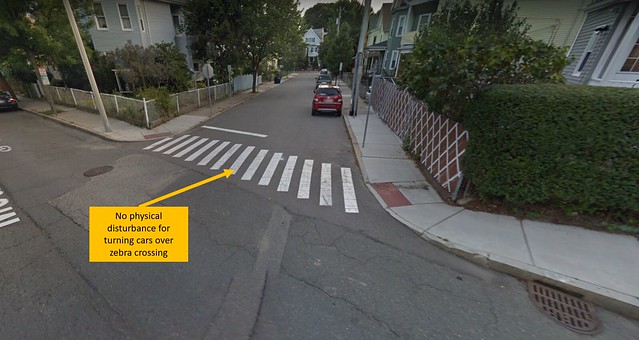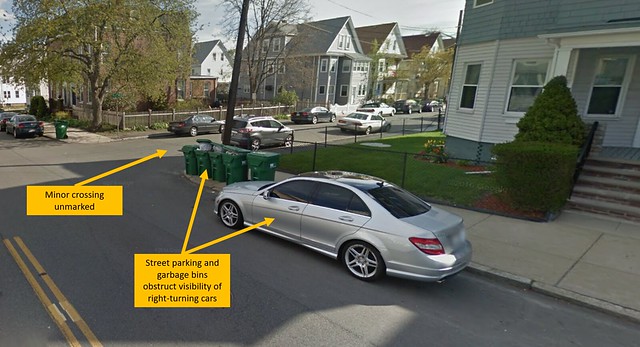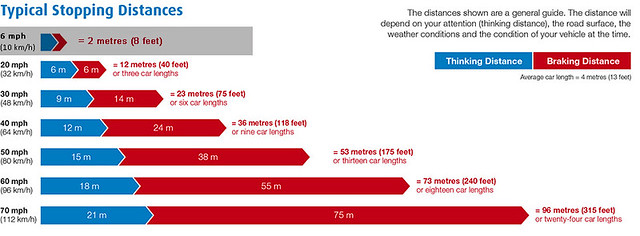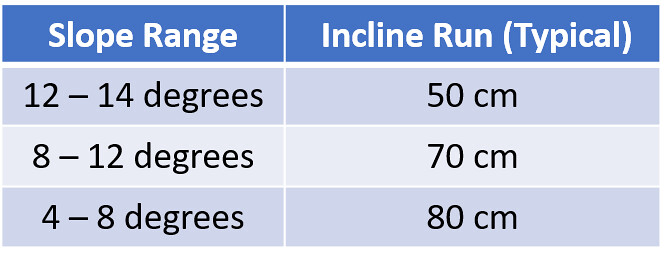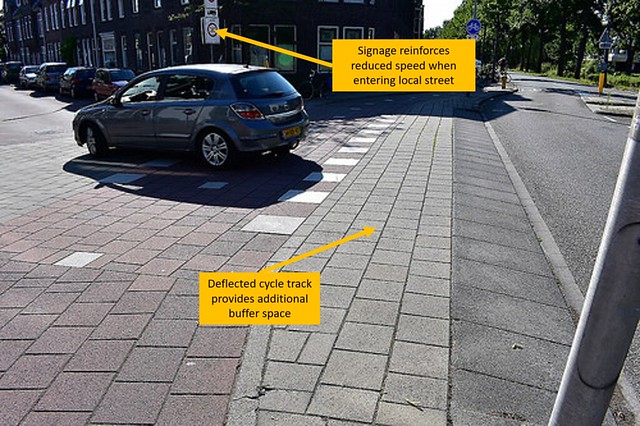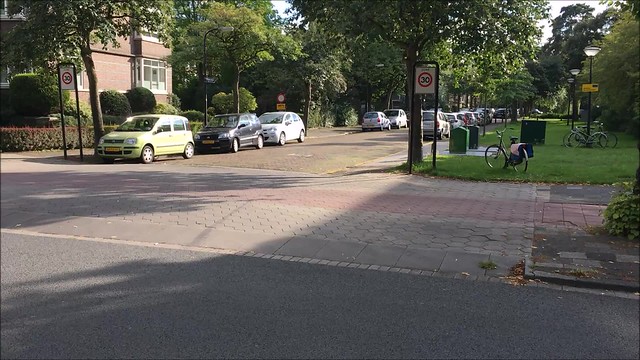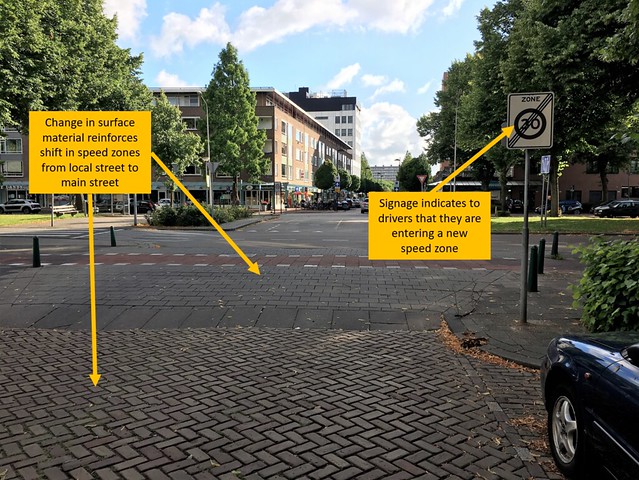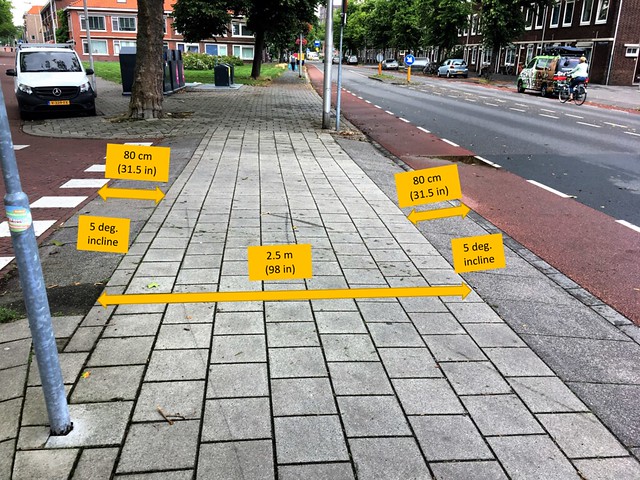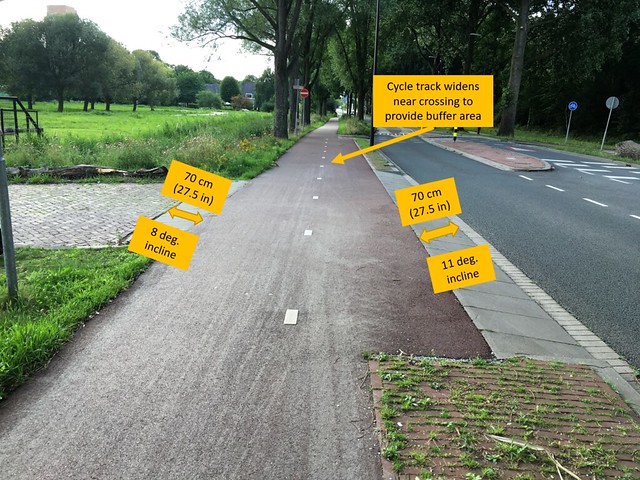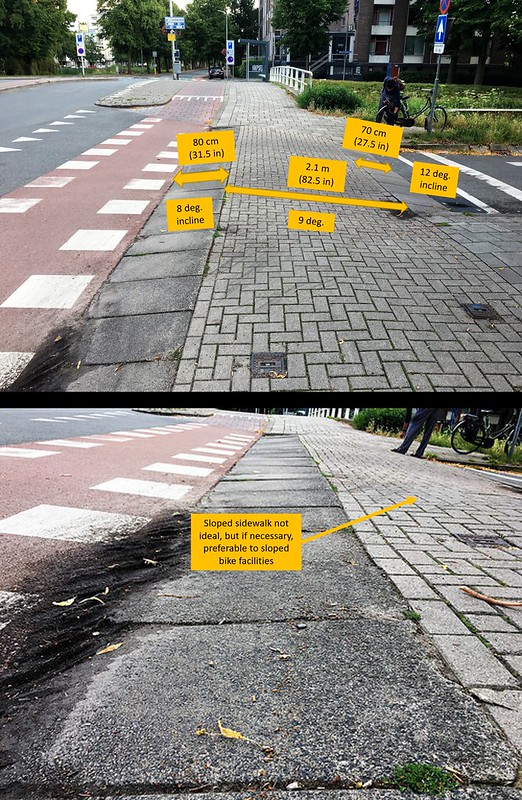1.2b 6 mph for quick stopping [Kevin & Yuhao]
Executive Summary
To deal with with potential conflict points between motor vehicles and cyclists or pedestrians at unsignalized minor intersections, the raised crossing is a road feature commonly seen throughout the Netherlands. These crossings serve as physical interventions for turning vehicles, forcing them to reduce speeds before entering the conflict zone, and continue traveling at slow speeds along the local road, access road, side street, or driveway. The raised crossing also serves as a communication tool, showing the transition region between a high-speed main road and low-speed street or driveway. Cars must ramp up to the level of the sidewalk and/or cycle track, heightening driver awareness and communicating priority for cyclists and pedestrians through these crossings. Figure 1 illustrates these main points. Depending on the specific location and intended street use, Dutch raised crossings vary in appearance and technical dimensions. Overall, the concept is relatively simple and cost-effective to implement. Where appropriate, the U.S. can emulate the Dutch raised crossing to improve safety for vulnerable individuals at minor crossings without traffic light control.
Figure 1 – The Dutch raised crossing concept
Introduction
The first principle of Dutch systematic safety is speed control and separation, which focuses on potential conflict points, the safe speed for vehicles to navigate these points, and the road design features that enforce that speed. Raised crossings are often used at conflict points where cars must cross paths belonging to cyclists (i.e. cycle tracks) and/or pedestrians (i.e. sidewalks) to ensure safety of cyclists and pedestrians. The most common situations for these conflicts are when cars turn off a main road onto a local street. Less common instances include turns onto a low-volume service road, side street, or driveway. Before vehicles conflict with bikes and pedestrians, they have to drive through a raised area. When approaching a sheer ramp, drivers will intuitively lower their speed to avoid discomfort caused by bumping – similar to the effect of speed humps. Cars cross the intersection at such low speeds that if a cyclist or pedestrian is not visible until the last second, the driver will be able to stop immediately and avoid crashing. When vehicles safely pass through the conflict zone, they descend back to the level of the road and continue driving. A typical Dutch raised crossing over a cycle track and sidewalk is shown in Figure 2.
Figure 2 – Typical raised crossing with heavy bike traffic
American vs. Dutch Application
An important feature of minor crossings is that they are unsignalized, since they are not major intersections. Therefore, cyclists and pedestrians are more vulnerable than they would be at a protected signalized crossing, and control measures other than traffic signals must be implemented to ensure safety. In the U.S., these minor crossings are often neglected, or handled by installing a simple “Yield to Pedestrians” sign, as shown below in Figure 3, and trusting the judgment and alertness of drivers.
Figure 3 – Yield sign commonly seen on U.S. roads
The rules for vehicles yielding to pedestrians are well-known across the board among American drivers. Drivers know to “look out” for vulnerable cyclists and pedestrians at all crossings, with signs serving as a reminder. However, drivers are accustomed to fast, uninterrupted travel on main roads at speeds of about 35-40 mph (55-65 kph). When turning off the main road, they may see a yield sign, but do not encounter any physical disruption in the road (Figure 4). Thus, drivers often speed past these turns, creating a danger for unprotected cyclists and pedestrians, especially in areas where a driver’s line of sight is compromised (Figure 5).
Figure 4 – Typical minor crossing seen in U.S.
Figure 5 – Minor crossing in U.S. with obstructed view
It takes a longer distance and time for a vehicle to come to a complete stop when traveling at higher speeds, as shown in Figure 6. 10 kph, or 6 mph, has been established as the safe speed for cars to navigate these turns, allowing for drivers to stop on a dime at the last second if necessary. At this speed, the typical stopping distance is 2 m, or 8 ft. Thus, per the Dutch CROW Manual, cycle tracks are typically set back 2-2.5 m from the main road at minor crossings with heavy vehicle traffic. This slow turning speed coupled with increased reaction time (longer distance) will prevent as many collisions from happening as possible, and reduce the consequences of collisions if they do happen.
Figure 6 – Typical stopping distances for motor vehicles
Key Design Details of Dutch Raised Crossings
Figure 7 illustrates key design details visually with a drawing of a typical Dutch raised crossing. Descriptions of the numbered labels are described below.
Figure 7 – Drawing of typical Dutch raised crossing highlighting key design details
1. Elevation:
A raised crossing is not a raised crossing unless it is elevated. Compared to the main road, the crossing is usually 8 to 15 cm (3 to 6 in) higher. Since the minor road is usually lower in elevation due to drainage concerns, the gap between crossing and minor road is usually bigger. In some cases a sloped cycle track or sidewalk is made to accommodate this difference.
2. Slope:
The slope is what actually makes vehicles slow down. In the Netherlands, the slope is usually between 6° and 12 °( 10% to 20%), with cases of 4° and 14° observed in some places. The slope needs to be sheer enough to make it uncomfortable to drive on at high speeds.
3. Run:
The ramp also should be long enough to allow drivers to brake until they reach the conflict zone. The run of the slope is usually 50 to 80 cm (20 to 30 in). In general, steeper slopes correlate to longer inclines, as shown in Table 1.
Table 1 – Slope ranges and corresponding inclines
4. Width:
The width of a raised crossing should fully accommodate the sidewalk and cycle tracks alongside the main road, if not bumped out at intersections, in which case the raised part is even wider.
5. Length:
The length of a raised crossing is greater or equal than the minor road’s width. In case of a narrow minor road or limited visibility, a funnel-shaped expansion can be expected.
Dutch Examples
The interactive map below highlights the two main regions where raised crossings were analyzed. The map may be used in satellite street view to explore some of these examples further.
Key Region #1: Delfgauwseweg (Delft)
Over a stretch of about 860 m, there are a total of six raised crossings along Delfgauwseweg (1+1 distributor road), as shown in Figure 8. This is notable because the street is a main street with fairly heavy car traffic (especially at rush hour) travelling at speeds of 50 km/hr. Speed humps are not designed on main streets, so raised crossings are depended on for cyclist and pedestrian safety. Intentionally, these turns are difficult and uncomfortable for cars to make, so they have no choice but to slow down to a crawl while driving over the crossing table.
Figure 8 – Locations of raised crossings along Delfgauwseweg
Figure 9 shows a typical raised crossing on Delfgauwseweg, at the intersection of Simonstraat. This is essentially a right angle turn for cars turning right, but visibility of cyclists and pedestrians is generally very good (i.e. no hidden spots), so a gradual incline of 6 degrees over 80 cm (height of 8.4 cm) is reasonable to slow motor vehicles before crossing the cycle track. Cars turning left will be yielding to oncoming traffic anyway, so they have extra distance and time to watch out for cyclists and pedestrians. Also noteworthy is the section of light gray brick on top of the crossing table but in front of the cycle track. This gives the driver a small buffer where stopping on a dime is possible if a cyclist comes racing by at the last second.
Figure 9 – Delfgauwseweg at Simonstraat
A similar raised crossing (intersection at Van Oldenbarneveltstraat) is shown in Figure 10 here with a car driving over the crossing table. As seen, the crossing table is wide and long enough so that drivers have plenty of time to react to oncoming cyclists or pedestrians, and the incline ensures that they will be doing so at very low speeds. The cycle track is also deflected at this raised crossing to provide a buffer region. At the end of the crossing table, another incline (50 cm, 12 deg. – not visible in picture) indicates the start of a local street, and signage indicates a reduction in speed limit to 30 km/hr. Cars are already exiting the raised crossing at very slow speeds, so this provides another function – ensuring speed reduction at transitions onto local streets.
Figure 10 – Delfgauwseweg at Van Oldenbarneveltstraat
Figure 11 shows a raised crossing on Delfgauwseweg just before the roundabout at the end of the street. The crossing leads onto a short service road with apartments and limited street parking. The road could also serve as a cut-through to bypass the roundabout and turn right onto Nassaulaan. Virtually no cars were observed to turn onto this road, but the raised crossing is still interesting to analyze. With a short, steep incline of 50 cm and 12 degrees (height of 10.4 cm), turning cars will slow down to almost a halt. The right turn is even sharper than that in Figure 9, to compensate for the shorter distance between the incline and cycle track. While the buffer area in Figure 9 is wider than in Figure 11, the design is still justified to enforce slow turns and cyclist/pedestrian safety. One area of concern is the limited visibility of drivers as they turn the corner just before the raised crossing. A green hedge between the street and cycle track partially obstructs this raised crossing so it is not really visible to drivers until the last second. While not ideal, the car traffic through this service road is likely so low that Dutch designers deemed this raised crossing to be “safe enough” for cyclists and pedestrians.
Figure 11 – Delfgauwseweg at service road before roundabout
Key Region #2: Huis te Lindelaan (Rijswijk)
Huis te Lindelaan is a 1+1 main distributor road in Rijskijk. The road is smooth and straight, encouraging through traffic to travel at high speeds. Similar to Delfgauwseweg, raised crossings are encountered frequently along the street. Right turning cars are quite common off of Huis te Lindelaan, as neighboring local streets have an abundance of residences and shops on either side. Despite the median separating the two directions of traffic, cars are still allowed to turn left, waiting in the refuge area of the median when necessary for a gap in traffic. When a gap does appear, drivers may have a tendency to “shoot the gap” and speed across the opposing lane of traffic, quickly crossing the intersection in a straight line. In this case, the raised crossing is once again effective in slowing cars and fighting the instinct to speed over the crossing. While left-turning drivers may have better visibility of oncoming cyclists and pedestrians than drivers making a standard right turn, complications can arise when multiple cars are passing over the crossing at once, compromising line of sight. This instance was observed a few times during our visit to Huis te Lindelaan.
The following video shows some of the concepts explained above as well as the overall effectiveness of raised crossings along Huis te Lindelaan.
Figure 12 shows the intersection of Huis te Lindelaan at Karel Doormanlaan. For a minor intersection, this exchange is relatively busy with car traffic turning onto the local street and coming out onto the main street. In addition to a standard incline of 8 degrees and 80 cm (height of 11 cm), street parking has been eliminated at the crossing to provide extra space for a buffer zone, so cars have ample time and space before crossing the cycle track and sidewalk. In total, cars have 6.9 m, or 272 in, to cross after clearing the initial incline. Bollards have also been added at the boundaries of this raised crossing to provide additional separation and definition for drivers, without obstructing cyclists or pedestrians.
Figure 12 – Huis te Lindelaan at Karel Doormanlaan
Figure 13 shows the intersection of Huis te Lindelaan at J.H.A. Schaperlaan. The incline here (4 degrees) is more gradual than other raised crossings, but the newly paved tiles and contrasting pattern design create the appearance of a funnel shape, as the crossing narrows down to a shorter opening to enter the local street. Thus, this example shows an alternative method to get cars to slow down without having a steep incline, and also shows the simplicity of adding a new raised crossing to an existing road, or repaving the crossing to create further definition and separation. The allusion of a “shrinking” region is also a key psychological element of this design to get cars to slow down.
Figure 13 – Huis te Lindelaan at J.H.A. Schaperlaan
Figure 14 shows the intersection of Huis te Landelaan at Henri Hubertus Van Kollan, taken from the angle of vehicles exiting the local street and crossing onto the main road. Signage indicates the change in speed zones, while the raised crossing and change in surface material provides the physical communication to drivers that they are entering a new region. This example shows how raised crossings can be effective from both angles, both entering and exiting a local street.
Figure 14 – Huis te Landelaan at Henri Hubertus Van Kollan
Other Dutch Examples
Figure 15 shows a raised crossing on Nassaulaan, at the intersection of Frederik Hendrikstraat (in Delft). This raised crossing features a gradual 7 degree incline over 80 cm (height of 9.8 cm) for cars turning off the main road, and a steep 14 degree incline over 50 cm (height of 12.1 cm) for cars turning onto the main road. This raised crossing is still effective at slowing down cars before turning onto the sidewalk, but does not really give protection to cyclists. This is one reason why the Dutch prefer separated cycle tracks to bike lanes, since the separation allows for more safeguards and safety measures that are not possible with on-street bike lanes on main roads.
Figure 15 – Nassaulaan at Frederik Hendrikstraat
Figure 16 shows a raised crossing at the intersection of Oostingel and Stalpaert Van Der Wieleweg in Delft. Similar to Figure 15, cyclists are unprotected by the raised crossing, but in this case, the local street is one-way, so cars from the main road cannot turn onto this street. The crossing is designed more for cars exiting the local street and turning onto the main street. Cars are already driving slowly in this case, so the lack of protection for cyclists is not critical, and the inclines are more gradual.
Figure 16 – Oostingel at Stalpaert Van Der Wieleweg
Figure 17 shows a raised crossing along Lange Kleiweg in Rijswijk. The side street leads into a gated parking lot with a soccer field, and could experience significant traffic before or after a big event. With an absence of street parking, there is little space here for a buffer area between the incline and raised cycle track. Thus, a sheer slope is designed with a sharper incline to slow vehicles, and the cycle track widens around the crossing to provide a makeshift buffer area and give drivers a little more time to react.
Figure 17 – Lange Kleiweg at parking lot entrance
Figure 18 shows the crossing of Sint Jorisweg at Aan Het Verlaat in Delft. In this particular situation, there is a relatively big difference between the elevation of the main road and that of the minor road. To accommodate this gap, we have an uneven sidewalk sloping downward at an angle of 9 degrees. Although this road has bike lanes instead of cycle tracks, if a cycle track were present, it would be preferable to keep it level here if possible, sloping only the sidewalk, since walking on an incline is much easier than biking on one.
Figure 18 – Sint Jorisweg at Aan Het Verlaat
Opportunity for U.S. Application
Figure 19 shows a raised crossing seen in Boston, MA along Hemenway St. This street carries relatively heavy pedestrian traffic, with apartments on both sides and many college students crossing through the area travelling to and from campus. This crossing specifically is designed for cars turning into a parking lot, but does not emulate the Dutch design. Visibly, the incline is the same color as the street, giving poor contrast and failing to give drivers a cue that they are about to cross a pedestrian sidewalk and enter a reduced speed zone. There is also no buffer area between the incline and the sidewalk, so if a driver saw a pedestrian at the last second, the front of the car would likely be overhanging the sidewalk already. The lack of an opposing incline at the other end of the sidewalk fails to separate the two regions, so cars do not experience any physical separation between the sidewalk and the beginning of the parking lot.
Figure 19 – Hemenway St. at parking lot entrance (Boston, MA)
A possible redesign of this raised crossing would bump out the curb to prevent street parking near the crossing, allowing for a larger crossing width and space for a buffer. A new surface treatment could be used for the incline to create a visual indicator for turning cars. An opposing incline could also be built leading into the parking lot on the other side of the sidewalk, following the Dutch convention. Given the sharp right angle turn into the parking lot, a steeper slope could be used to slow down cars quickly (especially if there is no buffer area), as seen in the Dutch examples.
Conclusion
According to the Dutch experience, a raised crossing is desirable when a main road, usually with high speed traffic, intersects with a minor road. Along the main road there are usually cycle tracks or bike lanes, as well as sidewalks to accommodate non-motorized traffic, for which raised crossings will provide a sufficient amount of protection.
The Dutch way of thinking proclaims that signage and street markings alone are ineffective. In the special case of unsignalized minor crossings, control must come in the form of a physical intervention, in addition to basic driver awareness and caution. Raised crossings are the main design feature to handle these types of conflict points. They serve several purposes, including the following:
- Providing a physical disturbance for turning vehicles, forcing drivers to slow down
- Creating a visual indicator for drivers that cyclists or pedestrians may be present
- Indicating priority for cyclists and pedestrians by raising cars to their level
- Creating a “transition region” between main roads (higher speeds) and local streets (lower speeds)
As applied in the Netherlands, the raised crossing is a simple design feature used to enforce speed control and separation at potential conflict points between cars, cyclists, and pedestrians. Designs for raised crossings vary depending on the specific function of the street, the level of traffic, visibility constraints, and other factors. In almost all situations, the raised crossing is effective in slowing cars, raising awareness for vulnerable individuals, and serving as a communication tool for drivers that they are changing speed zones. In the U.S., minor intersections are often neglected or overlooked, or raised crossings are implemented haphazardly and ineffectively. Emulating the Dutch example of raised crossings may contribute to making bike paths and sidewalks less stressful and more appealing for people to use in the U.S.



